We’d like to remind Forumites to please avoid political debate on the Forum.
This is to keep it a safe and useful space for MoneySaving discussions. Threads that are – or become – political in nature may be removed in line with the Forum’s rules. Thank you for your understanding.
One Parking Solution - Notice to Keeper / PCN
Comments
-
Hi All,
First draft of my POPLA Appeal. Any suggestion/ tips/ changes will be greatly appreciated. I separated into several parts as it is too long!
PART 1POPLA Verification Code: [XXX]
Vehicle Registration: [XXX]
I, the registered keeper of this vehicle, received a letter dated [XXX] acting as a notice
to the registered keeper. My appeal to the operator – One Parking Solution Ltd – was
submitted and acknowledged on [XXX] but subsequently rejected via an email dated
[XXX]. I contend that I, as the keeper, am not liable for the alleged parking charge and
wish to appeal against it on the following grounds:
1) Consideration and Grace Periods: BPA Code of Practice–non-compliance
2) The entrance signs are inadequately positioned and signs in this car park are not prominent, clear or legible from all parking spaces and there is insufficient notice of the sum of the parking charge itself
3) No Evidence of Landowner Authority - the operator is put to strict proof of full compliance with the BPA Code of Practice
4) Failure to comply with the data protection 'ICO Code of Practice' applicable to ANPR (no information about SAR rights, no privacy statement, no evaluation to justify that 24/7 ANPR enforcement at this site is justified, fair and proportionate). A serious BPA CoP breach
5) No Evidence of Period Parked – NtK does not meet PoFA2012 Requirements
6) Vehicle Images contained in PCN: BPA Code of Practice – non-compliance
7) The ANPR System is Neither Reliable nor Accurate
8) The Signs Fail to Transparently Warn Drivers of what the ANPR Data will be used for
9) No Planning Permission from Merton Borough Council for Pole-Mounted ANPR Cameras and no Advertising Consent for signage (NEED TO CHECK)
1. Grace Period: BPA Code of Practice – non-compliance
The BPA’s Code of Practice states (13) that there are two grace periods: one at the end (of a minimum of 5 minutes) and one at the start.
BPA’s Code of Practice (13.1) states that:
13.1 The driver must have the chance to consider the Terms and Conditions before entering into the ‘parking contract’ with you. If, having had that opportunity, the driver decides not to park but chooses to leave the car park, you must provide them with a reasonable consideration period to leave, before the driver can be bound by your parking contract. The amount of time in these instances will vary dependant on site size and type but it must be a minimum of 5 minutes.
BPA’s Code of Practice (13.2) states that:
13.2 The reference to a consideration period in 13.1 shall not apply where a parking event takes place.
BPA’s Code of Practice (13.3) states that:
13.3 Where a parking location is one where a limited period of parking is permitted, or where drivers contract to park for a defined period and pay for that service in advance (Pay & Display), this would be considered as a parking event and a Grace Period of at least 10 minutes must be added to the end of a parking event before you issue a PCN.
BPA’s Code of Practice (A8.4) states that:
If a driver is parking with your permission, they must have the opportunity to read the terms and conditions before they enter into the contract with you. If, having had that opportunity, they decide not to park but choose to leave the car park, you must provide them with a reasonable grace period to leave, as they will not be bound by your parking contract.
From the latest House of Commons Hansard (02 June 2020) debate: a 10-minute grace period to be applied.
Extract:
‘’The code was also to ensure that a mandatory 10-minute grace period, which already applies to local authority car parks, be extended to all private parking services’’
Kelvin Reynolds, Head of Public Affairs and Policy at the British Parking Association (BPA):
“The BPA’s guidance specifically says that there must be sufficient time for the motorist to park their car, observe the signs, decide whether they want to comply with the operator’s conditions and either drive away or pay for a ticket.”
“No time limit is specified. This is because it might take one person five minutes, but another person 10 minutes depending on various factors, not limited to disability.”
The BPA Code of Practice (13.1) clearly states that the Grace Period to leave the car park should be a minimum of 5 minutes. Whilst 13.1 does not apply in this case (it should be made clear - a contract was never entered in to), it is reasonable to suggest that the minimum of 5 minutes grace period stipulated in 13.3 is also a “reasonable grace period” to apply to 13.1 and 13.2 of the BPA’s Code of Practice.
(NOT SURE ABOUT THE ABOVE???)
It is therefore argued that the duration of visit in question (which One Parking Solution Ltd
claim was [xxx]) is not an unreasonable grace period, given:
a) The site is not well lit and relies on nearby street lighting as its primary source of lighting (REMOVE? as it occurred during the day)
b) Visibility was hindered further as the site was in darkness at time of the visit (REMOVE? as it occurred during the day)
c) The lack of sufficient signage throughout the car park and specific parking-terms signage throughout the car park in question (non- compliance with BPA Code of Practice 19.2 and 19.3) and the impact of that upon time taken to locate signage prior to entering into a contract.
d) There is a marked parking bay for 20 mins dropping off which causes confusion to the applicability of the One Parking Solution Ltd’s contract, that was never entered into in the first place.
e) The failure to make the signage visible from all parking spaces (which they are not, especially at nighttime) and legible once located.
f) The lengthiness of One Parking Solution Ltd’s signage (in terms of word count) all written in tiny text the across of the sign (see Figure 2 and 3).
All factors discussed above serve merely to increase the time taken to:
· Locate a sign indicating entrance
· Locate a sign containing the terms and conditions
· Read the full terms and conditions in the darkness
· Decipher the confusing information being presented
· Decide not to park and therefore not entering into a contract
· Return to car and safely leave the car park
“The BPA’s guidance specifically says that there must be sufficient time for the motorist to park their car, observe the signs, decide whether they want to comply with the operator’s conditions and either drive away or pay for a ticket.” “No time limit is specified. This is because it might take one person five minutes, but another person 10 minutes depending on various factors, not limited to disability.”
2. The entrance signs are inadequately positioned and lit and signs in this car park are not prominent, clear or legible from all parking spaces and there is insufficient notice of the sum of the parking charge itself
There was no contract nor agreement on the 'parking charge' at all. It is submitted that the driver did not have a fair opportunity to read about any terms involving this huge charge, which is out of all proportion and not saved by the dissimilar 'ParkingEye Ltd v Beavis' case.
In the Beavis case, which turned on specific facts relating only to the signs at that site and the unique interests and intentions of the landowners, the signs were unusually clear and not a typical example for this notorious industry. The Supreme Court were keen to point out the decision related to that car park and those facts only.
In the Beavis case, the £85 charge itself was in the largest font size with a contrasting colour background and the terms were legible, fairly concise and unambiguous. There were 'large lettering' signs at the entrance and all around the car park, according to the Judges.
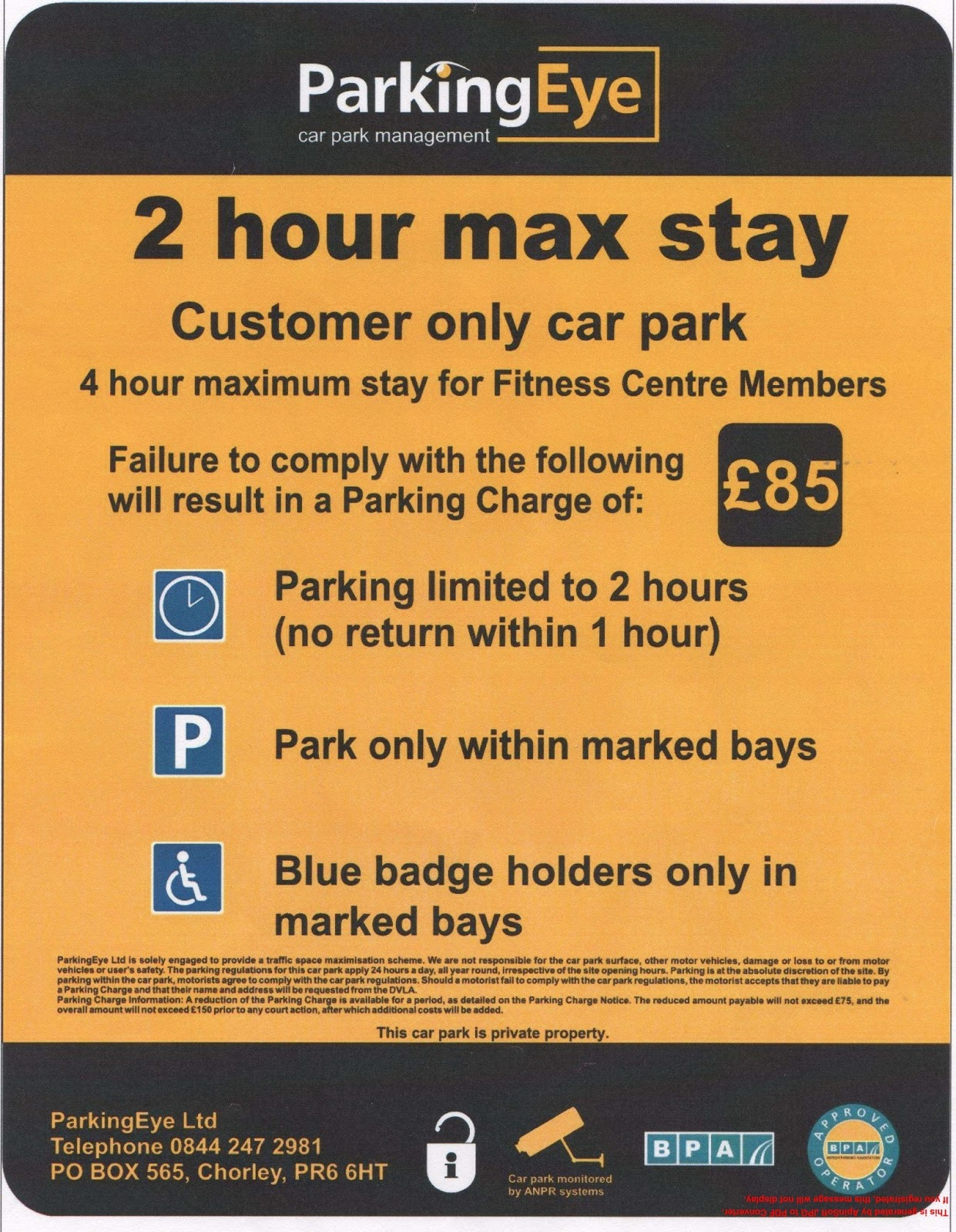
Figure 1: Beavis sign
This case, by comparison, does not demonstrate an example of the 'large lettering' and 'prominent signage' that impressed the Supreme Court Judges and swayed them into deciding that in the specific car park in the Beavis case alone, a contract and 'agreement on the charge' existed.
Here, the signs are sporadically and sparsely placed, indeed obscured and hidden in some areas. They are unremarkable, not immediately obvious as parking terms and the wording is mostly illegible, being crowded and cluttered with a lack of white space as a background. It is indisputable that placing letters too close together in order to fit more information into a smaller space can drastically reduce the legibility of a sign, especially one which must be read before the action of parking and leaving the car.
One Parking Solution’s main car park sign on the Plough Lane site (the only one of two in the car park displaying terms and conditions) is inadequate and illegible in a number of ways, not least because of the sheer amount of text that must be read (see Figure 2).
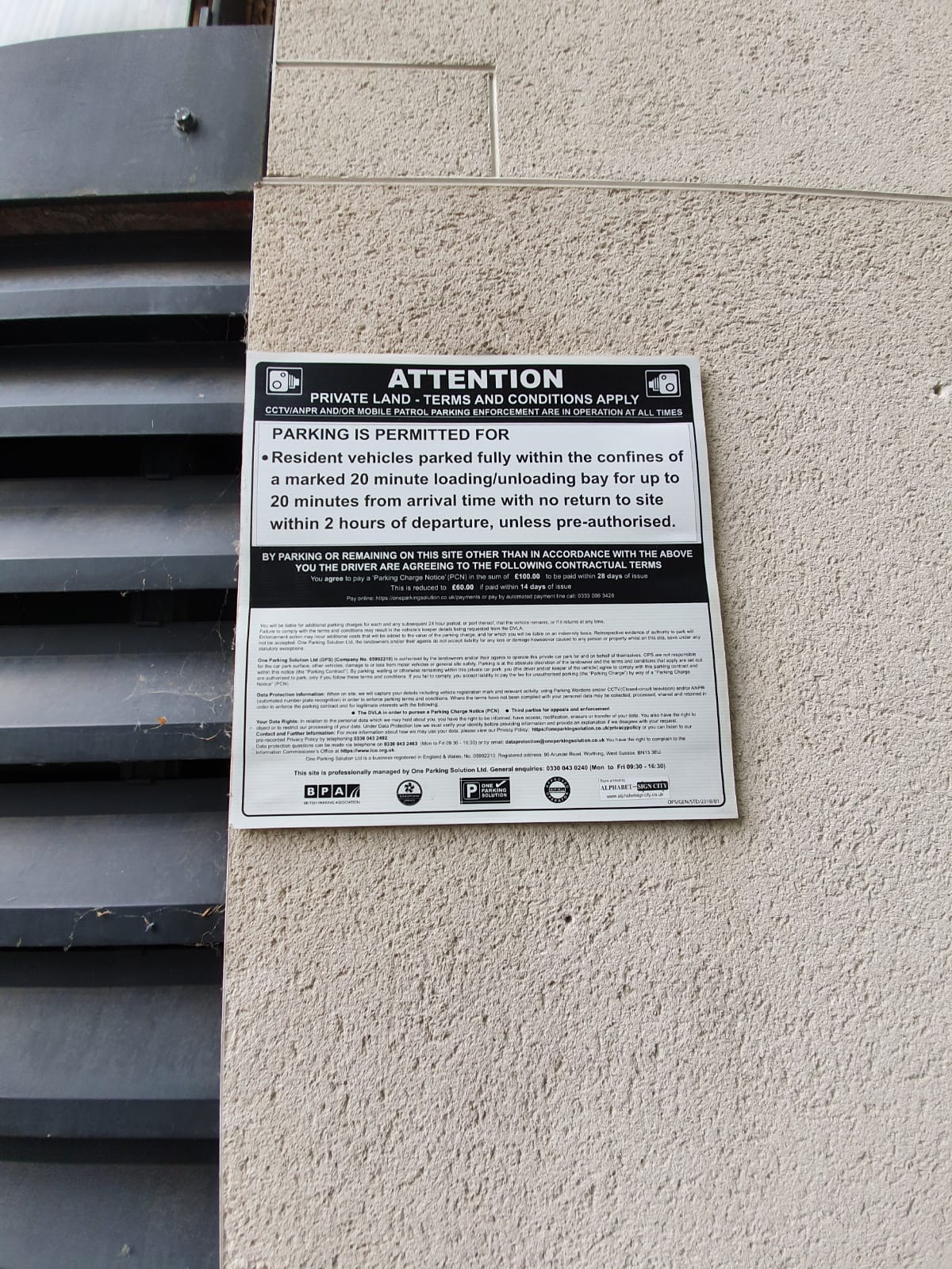
Figure 2: One Parking Solution sign – Plough Lane, main car park sign
The image in Figure 2 shows a close up of the main car park sign in the same lighting conditions as the date/time for which the PCN has been issued. (N.B. This image was taken whilst standing at ground level looking up with hands stretched fully while holding a camera, therefore it cannot be assumed that this is the view a person would have when standing below the sign. It should be emphasised that, when viewed from ground level, the text is even more difficult to read than it is in Figure 2).
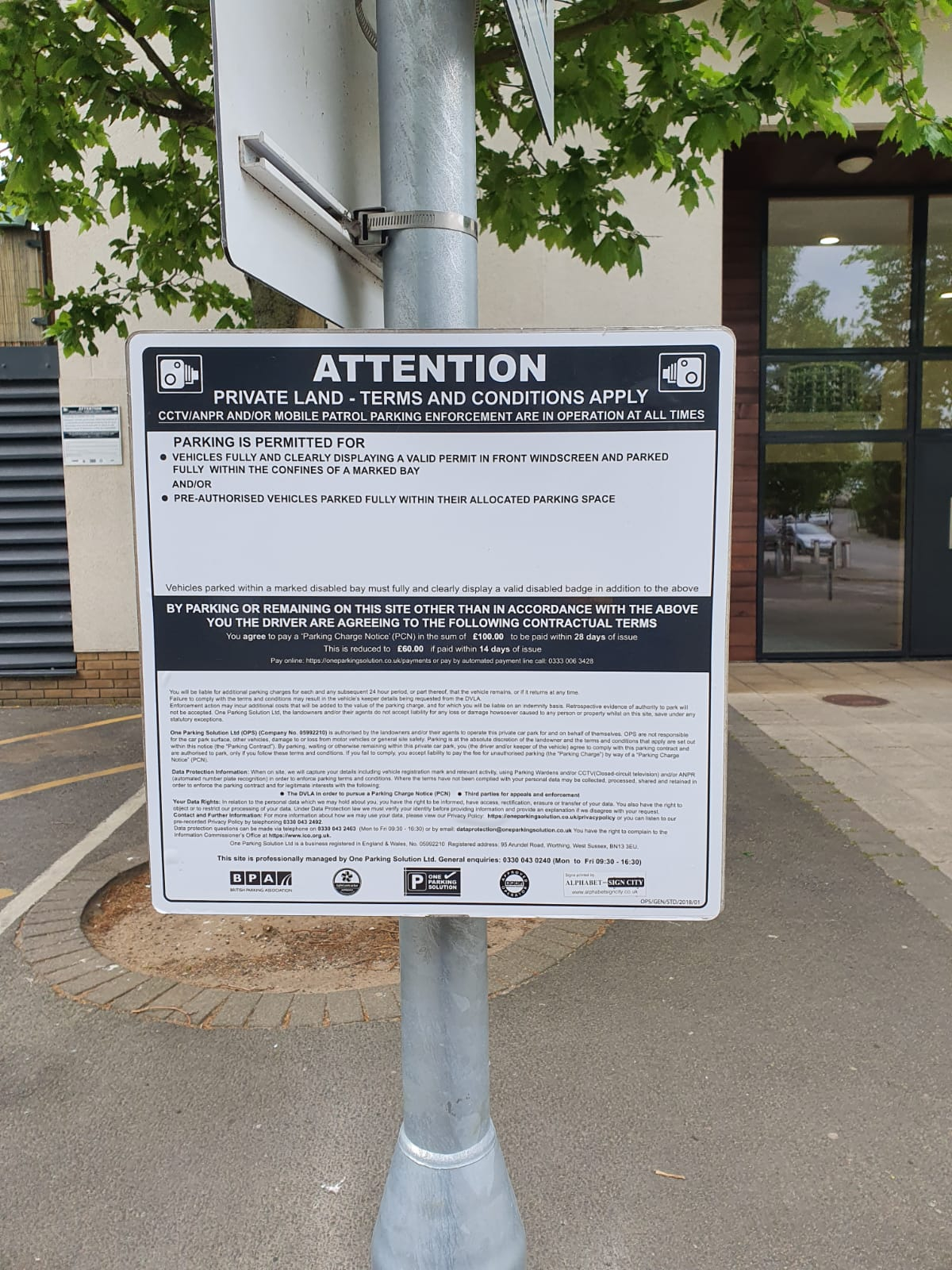
Figure 3: One Parking Solution sign
Figure 3 shows another sign with the same reading difficulty level as Figure 2. The Figure 3 signage is place on a pole, in such a position that it is only readable by drivers having to look away from the road ahead while driving.
Figure 2 and Figure 3 clearly show that One Parking Solution signage does not comply with the BPA Code of Practice (19.3), specifically:
“Signs must be conspicuous and legible, and written in intelligible language, so that they are easy to see, read and understand.”
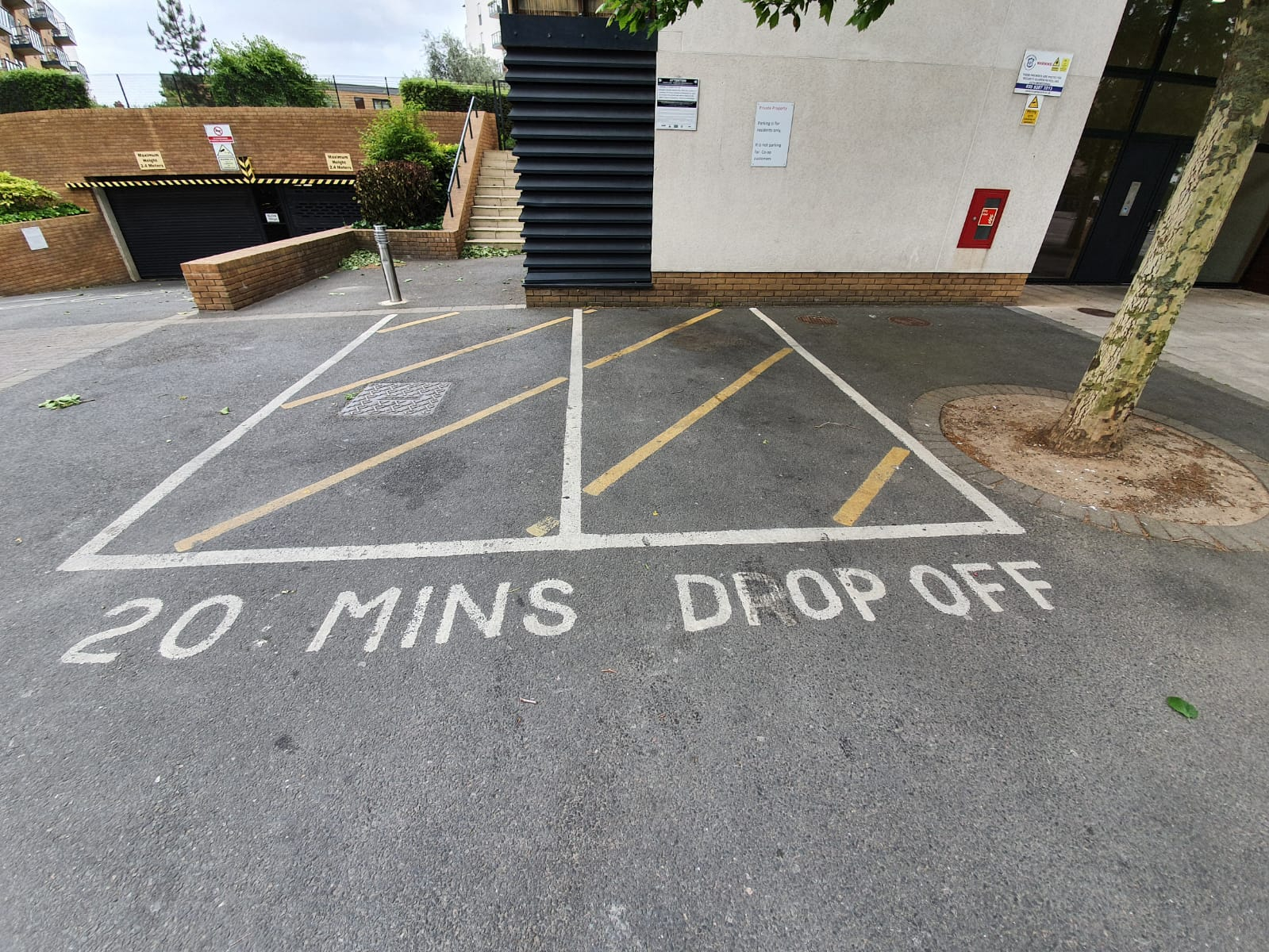
Figure 4: One Parking Solution Marking
Figure 4 gives the impression of an allowance of 20 mins for parking just to add to the confusion.
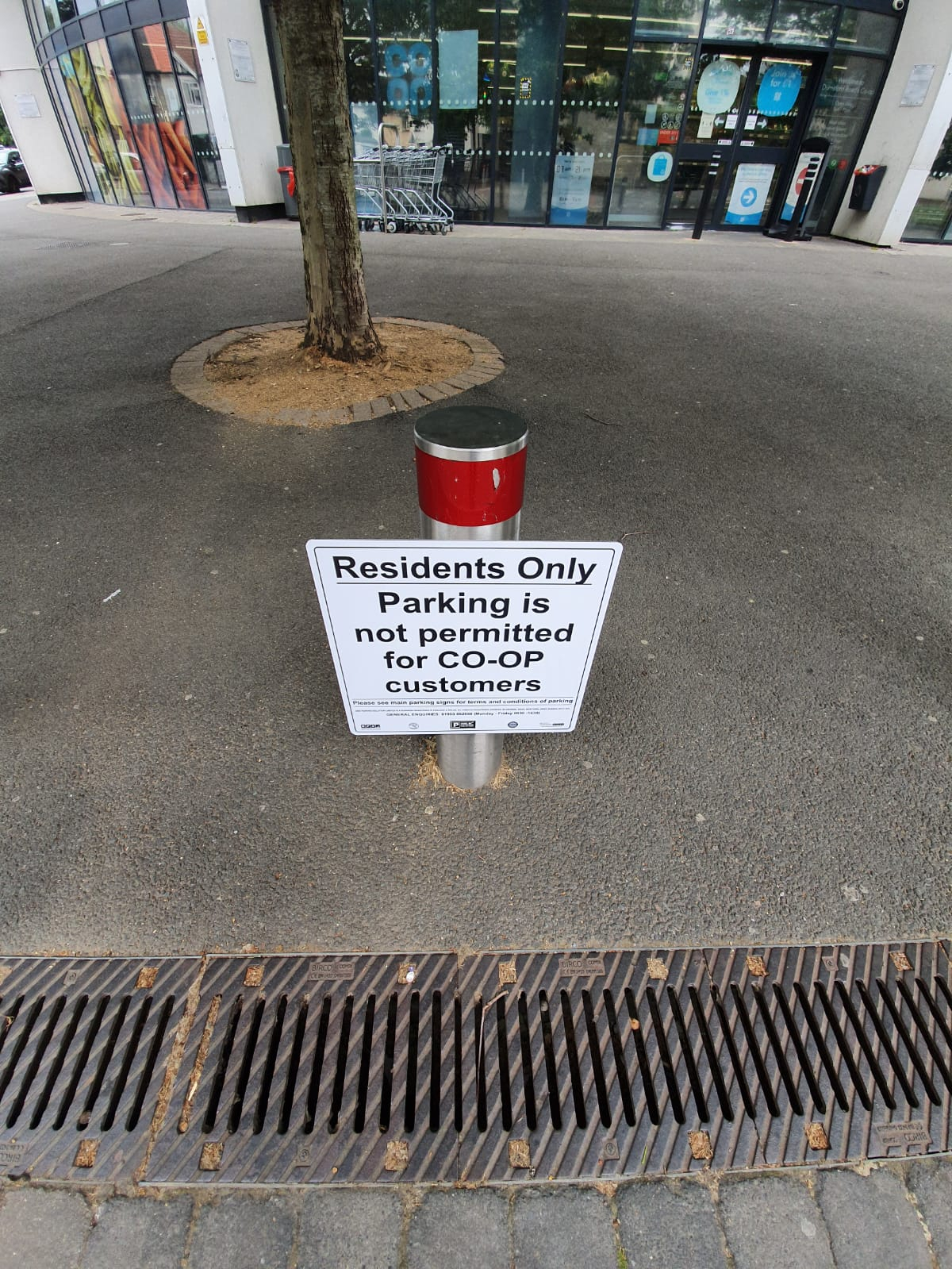
Figure 5 – no parking for Co-op customers sign
The sign attempts to forbid parking for Co-op customers, and therefore the PPC operator makes no contractual offer. So, a contract was not on offer, and it cannot have been, if parking is prohibited. The required basic elements of contract law are not met: no consideration (nothing of value) has been offered to the driver.
Finally, none of the signs tell drivers what the ANPR is being used for and none of the signs make an offer to Co-op customers.
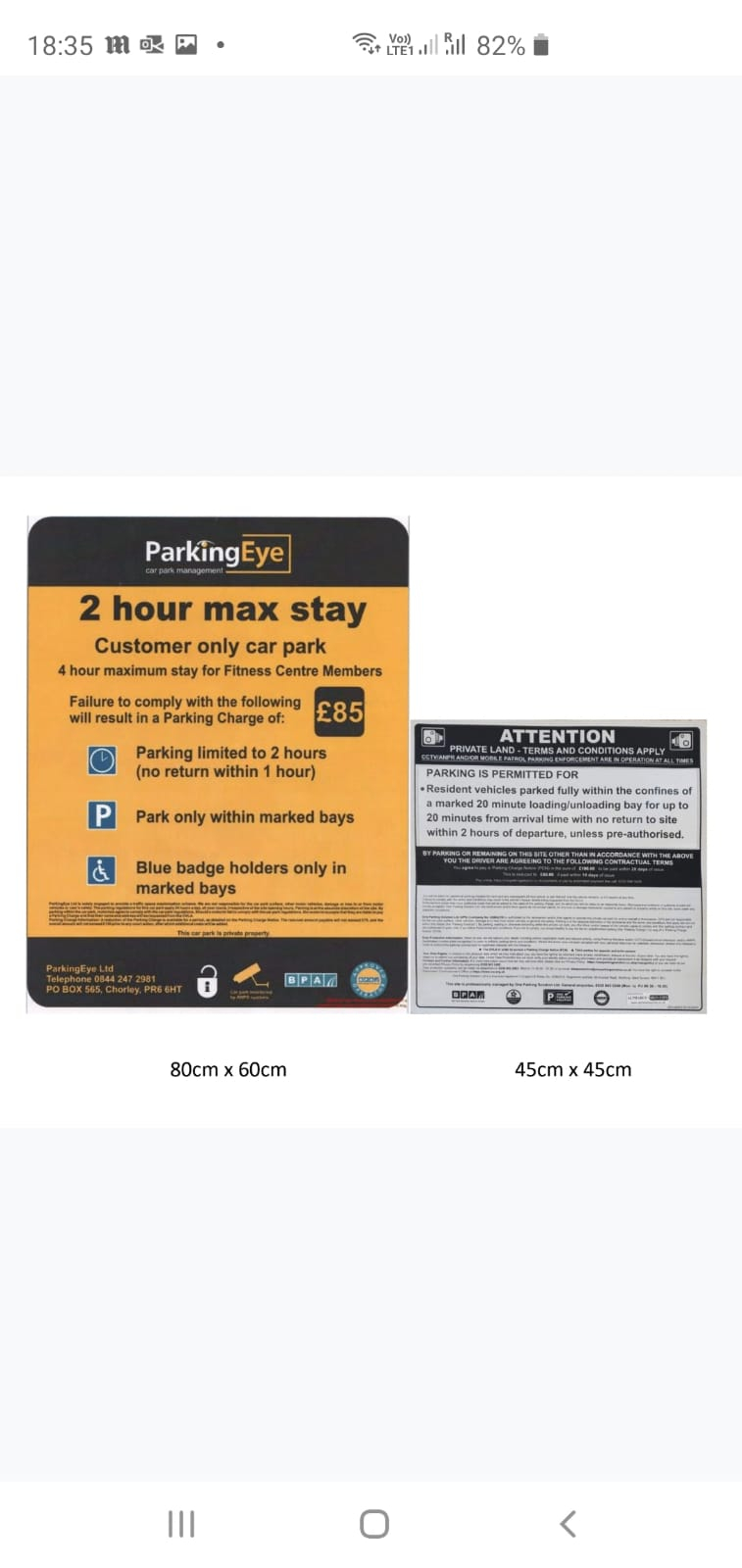
Figure 6: The Parking Eye Sign V the One Parking Solution Sign
3. No Evidence of Landowner Authority - the operator is put to strict proof of full compliance with the BPA Code of Practice
As this operator does not have proprietary interest in the land, I require that they produce an unredacted copy of the contract with the landowner. The contract and any 'site agreement' or 'User Manual' setting out details including exemptions - such as
any 'genuine customer' or 'genuine resident' exemptions or any site occupier's 'right of veto' charge cancellation rights – is key evidence to define what this operator is authorised to do and any circumstances where the landowner/firms on site in fact
have a right to cancellation of a charge. It cannot be assumed, just because an agent is contracted to merely put some signs up and issue Parking Charge Notices, that the agent is also authorised to make contracts with all or any category of visiting drivers
and/or to enforce the charge in court in their own name (legal action regarding land use disputes generally being a matter for a landowner only).
Witness statements are not sound evidence of the above, often being pre-signed, generic documents not even identifying the case in hand or even the site rules. A witness statement might in some cases be accepted by POPLA but in this case I
suggest it is unlikely to sufficiently evidence the definition of the services provided by each party to the agreement.
Nor would it define vital information such as charging days/times, any exemption clauses, grace periods (which I believe may be longer than the bare minimum times set out in the BPA Code of Practice) and basic information such as the land boundary
and bays where enforcement applies/does not apply. Not forgetting evidence of the various restrictions which the landowner has authorised can give rise to a charge and of course, how much the landowner authorises this agent to charge (which cannot be
assumed to be the sum in small print on a sign because template private parking terms and sums have been known not to match the actual landowner agreement).
Section 7 of the BPA Code of Practice defines the mandatory requirements and I put this operator to strict proof of full compliance:
7.2 If the operator wishes to take legal action on any outstanding parking charges, they must ensure that they have the written authority of the landowner (or their appointed agent) prior to legal action being taken.
7.3 The written authorisation must also set out:
a) the definition of the land on which you may operate, so that the boundaries of the land can be clearly defined
b) any conditions or restrictions on parking control and enforcement operations, including any restrictions on hours of operation
c) any conditions or restrictions on the types of vehicles that may, or may not, be subject to parking control and enforcement
d) who has the responsibility for putting up and maintaining signse) the definition of the services provided by each party to the agreement.
0 -
Part 2
4) Failure to comply with the data protection 'ICO Code of Practice' applicable to ANPR (no information about SAR rights, no privacy statement, no evaluation to justify that 24/7 ANPR enforcement at this site is justified, fair and proportionate). A serious BPA CoP breach
BPA’s Code of Practice (22.4) states that:
“It is also a condition of the Code that, if you receive and process vehicle or registered keeper data, you must:
· be registered with the Information Commissioner
· keep to the Data Protection Act
· follow the DVLA requirements concerning the data
· follow the guidelines from the Information Commissioner’s Office on the use of CCTV and ANPR cameras, and on keeping and sharing personal data such as vehicle registration marks
The guidelines from the Information Commissioner’s Office that the BPA’s Code of
Practice (22.4) refers to is the CCTV Code of Practice found at xxxx.com
The ICO’s CCTV Code of Practice makes the following assertions:
“This code also covers the use of camera related surveillance equipment including:
• Automatic Number Plate Recognition (ANPR);”
“the private sector is required to follow this code to meet its legal obligations under the DPA. Any organization using cameras to process personal data should follow the recommendations of this code.”
“If you are already using a surveillance system, you should regularly evaluate whether it is necessary and proportionate to continue using it.”
“You should also take into account the nature of the problem you are seeking to address; whether a surveillance system would be a justified and an effective solution, whether better solutions exist, what effect its use may have on individuals”
“You should consider these matters objectively as part of an assessment of the scheme’s impact on people’s privacy. The best way to do this is to conduct a privacy impact assessment. The ICO has produced a ‘Conducting privacy impact assessments code of practice’ that explains how to carry out a proper assessment.”
“If you are using or intend to use an ANPR system, it is important that you undertake a privacy impact assessment to justify its use and show that its introduction is proportionate and necessary.”
“Example: A car park operator is looking at whether to use ANPR to enforce parking restrictions. A privacy impact assessment is undertaken which identifies how ANPR will address the problem, the privacy intrusions and the ways to minimize these intrusions, such as information being automatically deleted when a car that has not contravened the restrictions leaves a car park.”
“Note:
... in conducting a privacy impact assessment and an evaluation of proportionality and necessity, you will be looking at concepts that would also impact upon fairness under the first data protection principle. Private sector organisations should therefore also consider these issues.”
“A privacy impact assessment should look at the pressing need that the surveillance system is intended to address and whether its proposed use has a lawful basis and is justified, necessary and proportionate.”
The quotations above taken directly from the ICO’s CCTV Code of Practice state that if One Parking Solution Ltd wish to use ANPR cameras then they must undertake a privacy impact assessment to justify its use and show that its introduction is proportionate and necessary. It also states that One Parking Solution Ltd must regularly evaluate whether it is necessary and proportionate to continue using it.
It therefore follows that I require One Parking Solution Ltd to provide proof of regular privacy impact assessments in order to comply with the ICO’s CCTV Code of Practice and BPA’s Code of Practice. I also require the outcome of said privacy impact assessments to show that its use has “a lawful basis and is justified, necessary and proportionate”.
The ICO’s CCTV Code of Practice goes on to state:
“5.3 Staying in Control
Once you have followed the guidance in this code and set up the surveillance system, you need to ensure that it continues to comply with the DPA and the code’s requirements in practice. You should:
• tell people how they can make a subject access request, who it should be sent to and what information needs to be supplied with their request;”
“7.6 Privacy Notices
It is clear that these and similar devices present more difficult challenges in relation to providing individuals with fair processing information, which is a requirement under the first principle of the DPA. For example, it will be difficult to ensure that an individual is fully informed of this information if the surveillance system is airborne, on a person or, in the case of ANPR, not visible at ground level or more prevalent then it may first appear.
One of the main rights that a privacy notice helps deliver is an individual’s right of subject access.”
One Parking Solution Ltd has not stated on their signage a Privacy Notice explaining the keepers right to a Subject Access Request (SAR). In fact, One Parking Solution Ltd has not stated a Privacy Notice or any wording even suggesting the keepers right to a SAR on any paperwork, NtK, reminder letter or rejection letter despite there being a Data Protection heading on the back of the NtK. This is a mandatory requirement of the ICO’s CCTV Code of Practice (5.3 and 7.6) which in turn is mandatory within the BPA’s Code of Practice and a serious omission by any data processor using ANPR, such that it makes the use of this registered keeper’s data unlawful.
As such, given the omissions and breaches of the ICO’s CCTV Code of Practice, and in turn the BPA’s Code of Practice that requires full ICO compliance as a matter of law,
POPLA will not be able to find that the PCN was properly given.
5) No Evidence of Period Parked – NtK does not meet PoFA2012 Requirements
Contrary to the mandatory provisions of the BPA Code of Practice, there is no record to show that the vehicle was parked versus attempting to read the terms and conditions before deciding against parking/entering into a contract.
PoFA 2012 Schedule 4 paragraph 9 refers at numerous times to the “period of parking”. Most notably, paragraph 9(2)(a) requires the NtK to:
“specify the vehicle, the relevant land on which it was parked and the period of parking to which the notice relates;”
One Parking Solution Ltd’s NtK simply claims that the vehicle “entered [xxx] at [xxx] and departed at [xxx]”. At no stage does Smart Parking Ltd explicitly specify the “period of parking to which the notice relates”, as required by POFA 2012.
One Parking Solution Ltd uses ANPR (while failing to comply with the data protection 'ICO Code of Practice' applicable to ANPR) to capture images of vehicles entering and leaving the vast unbounded and unmarked area to calculate their length of stay. Any vehicle passing by will be captured by ANPR. One Parking Solution Ltd, however, does not provide any direct evidence of its alleged violation. It is not in the gift of One Parking Solution Ltd to substitute “entry/exit” or “length of stay” in place of the POFA requirement - “period of parking” - and hold the keeper liable as a result.
By virtue of the nature of an ANPR system recording only entry and exit times, One Parking Solution Ltd are not able to definitively state the period of parking.
I require One Parking Solution Ltd to provide evidence to show the vehicle in question was parked on the date/time (for the duration claimed) and at the location stated in the NtK.
6) Vehicle Images contained in PCN: BPA Code of Practice – non-compliance
The BPA Code of Practice point 20.5a stipulates that:
"When issuing a parking charge notice you may use photographs as evidence that a vehicle was parked in an unauthorized way. The photographs must refer to and confirm the incident which you claim was unauthorized. A date and time stamp should be included on the photograph. All photographs used for evidence should be clear and legible and must not be retouched or digitally altered."
The NtK in question contains two close-up license plate images. The time and date stamp and license plate have been inserted into the underneath (but not part of) the images. In addition, the first image does not even show a vehicle, only an inserted image of the license plate and time stamp. Given the vast area that has neither been bounded nor marked as parking restricted, any vehicle passing by can be captured by One Parking Solution Ltd’s APRN. As a result, these images cannot be used as the confirmation of the incident and One Parking Solution Ltd claim was unauthorized.
I require One Parking Solution Ltd to produce evidence of the original images containing the
required date and time stamp and images showing the car is actually parked in the location stated rather than just passing by. Given the unbounded nature of the venue, failing to produce such evidence would indicate the One Parking Solution Ltd has been using APRN to engage random license plate collection of all vehicles passing by and send NtK with the aim to extract penalty. Such action is no different from sticking parking tickets to all vehicles passing by.
Recent investigation (27 Apr 2018) by BBC (link removed) shows that the private parking industry is unregulated and does not have any accountability.
Various cases show the industry’s priority is maximizing the penalty received from the motorist without due regard to the integrity of the evidence. Private parking operators are financially incentivized not to use the original image as evidence, but putting partial evidence together to generate a case biased towards generating a penalty fee. Based on the fact above, I require Smart Parking Ltd to produce strong evidence, audited by qualified third party, to prove that its process is not biased to suit its financial objective.
7) The ANPR System is Neither Reliable nor Accurate
One Parking Solution Ltd’s NtK simply claims “that the vehicle “entered [xxx] at [xxx] and departed at [xxx]”. One Parking Solution Ltd states the images and time stamps are collected by its ANPR camera system installed on site.
In terms of the technology of the ANPR cameras themselves, POPLA please take note and bin your usual 'ANPR is generally OK' template because:
The British Parking Association DOES NOT AUDIT the ANPR systems in use by parking operators, and the BPA has NO WAY to ensure that the systems are in good working order or that the data collected is accurate. Independent research has NOT found that the technology is 'generally accurate' or proportionate, or reliable at all, and this is one of the reasons why Councils are banned from using it in car parks.
As proof of this assertion here are two statements by the BPA themselves, the first one designed to stop POPLA falling into error about assumed audits:
Steve Clark, Head of Operational Services at the BPA emailed a POPLA 'wrong decision' victim back in January 2018 regarding this repeated misinformation about BPA somehow doing 'ANPR system audits', and Mr Clark says:
"You were concerned about a comment from the POPLA assessor who determined your case which said:
"In terms of the technology of the cameras themselves, the British Parking Association audits the camera systems in use by parking operators in order to ensure that they are in good working order and that the data collected is accurate"
You believe that this statement may have been a contributory factor to the POPLA decision going against you, and required answers to a number of questions from us.
This is not a statement that I have seen POPLA use before and therefore I queried it with them, as we do not conduct the sort of assessments that the Assessor alludes to.
POPLA have conceded that the Assessor's comments may have been a misrepresentation of Clause 22.3 of the BPA Code which says:
''22.3 You must keep any ANPR equipment you use in your car parks in good working order. You need to make sure the data you are collecting is accurate, securely held and cannot be tampered with. The processes that you use to manage your ANPR system may be audited by our compliance team or our agents.''
Our auditors check operators compliance with this Code clause and not the cameras themselves.''
Secondly, ANPR data processing and/or system failure is well known, and is certainly inappropriate in a mixed retail and residential area, such as the location in question.
The BPA even warned about ANPR flaws:
link removed Other-Advice#4
''As with all new technology, there are issues associated with its use'' and they specifically mention the flaw of assuming that 'drive in, drive out' events are parking events. They state that: ''Reputable operators tend not to uphold charge certificates issued in this manner''.
In this case, as the driver drove in and briefly stopped where there are no signs or bays at all (not in any retail area, but at a private residence not signed as being managed by One Parking Solution Ltd) the ANPR system has indeed failed and the operator has breached the first data protection principle by processing flawed data from their system.
Excessive use of ANPR 24/7 when such blanket coverage is overkill in terms of data processing, was also condemned by the BPA and the ICO:
linke removed
As POPLA can see from that, excessive use of ANPR is in fact, illegal, and no-one audits it except for the ICO when the public, or groups, make complaints.
One Parking Solution Ltd is put to strict proof that the system has not failed visitors to the residential homes within this site.
POPLA cannot use your usual 'the BPA audits it' erroneous template which needs consigning to the bin.
Please show the above email from Steve Clark, to your Lead Adjudicator.
Kindly stop assuming ANPR systems work, and expecting consumers to prove the impossible about the workings of a system over which they have no control but where independent and publicly available information about its inherent failings is very readily available.
0 -
Part 3
8) The Signs Fail to Transparently Warn Drivers of what the ANPR Data will be used for
The signs fail to transparently warn drivers of what the ANPR data will be used for which breaches the BPA Code of Practice and the Consumer Protection from Unfair Trading Regulations 2008 due to inherent failure to indicate the 'commercial intent' of the cameras.
Paragraph 22.1 of the BPA Code of Practice advises operators that they may use ANPR camera technology to manage, control and enforce parking in private car parks, as long as they do this in a reasonable, consistent and transparent manner. The Code of Practice requires that car park signs must tell drivers that the operator is using this technology and what it will use the data captured by ANPR cameras for.
One Parking Solution Ltd’s signs do not comply with these requirements because these car park signage failed to accurately explain what the ANPR data would be used for, which is a 'failure to identify its commercial intent', contrary to the BPA CoP and Consumer law.
There is no information indicates that these camera images would be used in order to issue Parking Charge Notices. There is absolutely no suggestion in the sentence above that the cameras are in any way related to Parking Charge Notices.
9) No Planning Permission from Merton Borough Council for Pole-Mounted ANPR Cameras and no Advertising Consent for signage
A search in Merton Borough’s planning database does not show any planning permission for the pole-mounted ANPR camera for the Plough Lane location, nor does it show any advertising consent for signage exceeding 0.3m2.
UK government guidance on advertisement requires:
“If a proposed advertisement does not fall into one of the Classes in Schedule 1 or Schedule 3 to the Regulations, consent must be applied for and obtained from the local planning authority (referred to as express consent in the Regulations).
Express consent is also required to display an advertisement that does not comply with the specific conditions and limitations on the class that the advertisement would otherwise have consent under.
It is criminal offence to display an advertisement without consent.”
This clearly proves One Parking Solution Ltd is/has been seeking to enforce Terms &
Conditions displayed on illegally erected signage, using equipment (pole-mounted ANPR cameras) for which no planning application had been made.
I request One Parking Solution Ltd provides evidence that the correct Planning Applications were submitted (and approved) in relation to the pole-mounted ANPR cameras and that Advertising Consent was gained for signage exceeding 0.3 m2, prior to the date to which this appeal relates (9 May 2020).
0 -
You don't need the yellow PE sign twice. Just have it next to the OPS sign and change the wording to suit.
Get rid of the intro before we scream. I hate that grammatical aberration with ''I'' followed by a comma. It's not good English. Where did you copy that from, is it a link in the NEWBIES thread? If so, I will chop it now. It is so horrible I stopped reading, so please remove it!I, the registered keeper of this vehicle, received a letter dated [XXX] acting as a notice to the registered keeper. My appeal to the operator – One Parking Solution Ltd – was submitted and acknowledged on [XXX] but subsequently rejected via an email dated [XXX]. I contend that I, as the keeper, am not liable for the alleged parking charge and wish to appeal against it on the following grounds:My first impression was, don't have a close up pic of an OPS sign.PRIVATE 'PCN'? DON'T PAY BUT DON'T IGNORE IT (except N.Ireland).
CLICK at the top or bottom of any page where it says:
Home»Motoring»Parking Tickets Fines & Parking - read the NEWBIES THREAD2 -
1. Grace Period: BPA Code of Practice – non-compliance
The BPA’s Code of Practice states (13) that there are two grace periods: one at the end (of a minimum of 5 minutes) and one at the start.No it doesn't.
a) The site is not well lit and relies on nearby street lighting as its primary source of lighting (REMOVE? as it occurred during the day)
b) Visibility was hindered further as the site was in darkness at time of the visit (REMOVE? as it occurred during the day)Obviously.
We are keen to help but, please...don't ask us stuff like this. No idea why it's in your draft?
I am still amazed anyone would park there for the Co-op. Why?
PRIVATE 'PCN'? DON'T PAY BUT DON'T IGNORE IT (except N.Ireland).
CLICK at the top or bottom of any page where it says:
Home»Motoring»Parking Tickets Fines & Parking - read the NEWBIES THREAD1 -
Also - "BPA’s Code of Practice (A8.4) states that:" - I think think A8.4 relates to N.I.2
-
Hi Coupon-mad,
''I'' followed by a comma is in the both samples of the POPLA appeals...
The driver used the co-op as there were no queues in comparison to some of the other supermarkets!
1 -
Hi 1505grandad,
A8.4 does indeed relate to N.I. - now removed.
Thanks
0 -
It won't be when I remove them...PRIVATE 'PCN'? DON'T PAY BUT DON'T IGNORE IT (except N.Ireland).
CLICK at the top or bottom of any page where it says:
Home»Motoring»Parking Tickets Fines & Parking - read the NEWBIES THREAD1
Confirm your email address to Create Threads and Reply

Categories
- All Categories
- 352.9K Banking & Borrowing
- 253.9K Reduce Debt & Boost Income
- 454.7K Spending & Discounts
- 246K Work, Benefits & Business
- 602.1K Mortgages, Homes & Bills
- 177.8K Life & Family
- 259.9K Travel & Transport
- 1.5M Hobbies & Leisure
- 16K Discuss & Feedback
- 37.7K Read-Only Boards





